2019 Indian Chieftain Dark Horse Review - First Ride

Modern styling with the same functional chassis
When I first saw Indian’s photos of the updated Chieftain line, I immediately thought of the presentation during the 2015 Indian Scout introduction. During his speech, Gary Gray, Indian Motorcycle Product Director, said that with Indian’s initial models under Polaris ownership, “we needed to earn the right to change the brand. So, how do you earn the right? You pay the deepest respects you can for the brand, and you pay honor to the people that came before you, and you build a bike that people clearly will see as an Indian.” All of the Indian models prior to the Scout were classically styled in a way that harkened back to the company’s early history, the nod to the past that Gray referred to.
2019 Indian Chieftain Dark Horse
| Engine | 18.0/20 |
| Suspension/Handling | 13.0/15 |
| Transmission/Clutch | 8.5/10 |
| Brakes | 8.25/10 |
| Instruments/Controls | 4.5/5 |
| Ergonomics/Comfort | 8.75/10 |
| Appearance/Quality | 9.25/10 |
| Desirability | 9.0/10 |
| Value | 8.0/10 |
| Overall Score | 87.25/100 |
Indian Announces Updated Chieftain For 2019
However, the Scout was the shot across the bow of the classic mindset, a statement that the company refused to get mired by the weight of history and, instead, intended to become a manufacturer of modern Indians. According to Gray, “We see the Scout as our first opportunity to say, ‘Now it’s time to honor the brand in the way only the brand itself can, to take it and evolve it, to make it grow and to bring it forward.’ The Scout is the first step forward in progressing the brand and making it the Indian Motorcycle of today, not the Indian Motorcycle of 1953.”
When looking at the 2019 Indian Chieftain line, it’s impossible not to see Gray’s statements in play. (And that’s before we even consider the upcoming unveiling of the Indian FTR1200 in a couple of weeks at Intermot.) To make matters even more interesting, at the 2019 Chieftain press briefing, we learned the updates to the design were also driven by customer requests for a more modern, aggressive styling for Indian baggers. Indian acknowledged that some riders still favor the more vintage style of the previous generation, so the Indian Chieftain Classic will stay in the line, visually unchanged, while still benefiting from performance and comfort upgrades that the entire Chieftain line received.
The beauty of skin deep
The 2019 Chieftain line is not a ground-up makeover where the whole kit-and-caboodle gets revisualized. Instead, the underlying Chieftain chassis remains essentially unchanged. What has received the graces of the Polaris designers’ attentions were the front fender, the fairing, the seat, and the saddlebags. From those simple changes, a striking new profile was cut.
The front fender loses its valances in favor of a sportier cut similar to the fender first seen on the 2017 Chieftain Elite and Limited. Since the valenced fender also covered the dual discs, the fender was significantly wider than what is required to just cover the front tire. So, for 2019, a new, slightly narrower Indian headdress takes up residence on the skinny fender, unlike on the previous Elite and Limited models.
Although the fairing retains the Chieftain’s signature round headlight, the lines of the fairing are more angular and aggressive. I’m sure that I’m not the only one who sees more than a little hint of Victory styling in the fairing. Some of the same hands who penned the Victory motorcycles must have been involved in this update. The same can be said for the new saddlebags. Their lines have become more angular while retaining the same capacity and power locks. The new, one-piece hinges add to the aerodynamic appearance. Tucked between the fender and the saddlebags, removable, color-matched fender closeouts fill what was an unsightly gap. However, the closeouts are easily removable to allow a passenger backrest to be installed. The rearward-sloping profile of the Chieftain is accentuated by the Rogue gunfighter seat that debuts this year.
Functional changes
The 2019 update to the Chieftain line wasn’t all window dressing, though. Two notable changes were made: one for performance and the other for rider comfort. Riders are sure to appreciate the new ride modes. The three settings – Tour, Standard, and Sport – alter how the throttle body’s butterfly reacts to the movement of the twist grip. In Tour, throttle inputs are softened for an emphasis on smooth riding. Folks who travel two-up will likely appreciate this setting. Standard delivers a more linear throttle response similar to that of cable operated throttles of the past. Sport provides the most responsive throttle application with each degree of the grip’s rotation causing a greater amount of throttle butterfly opening than with Standard mode. All modes deliver the same peak power.
Out on the road, the ride modes provided the type of performance that their names implied. I found that Tour was good for negotiating traffic around town and on the highway. However, because I liked the 1:1-feeling of the grip movement to throttle opening, I tended to stay in Standard for most of the riding – until the road got twisty. Sport made exiting corners tremendous fun. The throttle response was never abrupt when rolling through on-off-on transitions in any mode. Still, unless I was in a situation where I was planning on dragging floorboards, I kept the ride mode set to Standard. My only complaint about the Chieftain’s ride modes is that changing them requires taking your hand off of the grip and touching the Ride Command’s screen a couple times. Having a switch that allows for the modes to be toggled through would be much easier. After the mode is selected, the rider merely needs to roll the throttle completely closed for the change to take effect.
The second change to the engine compartment is also software-related. Indian now equips Chieftains with Rear Cylinder Deactivation. In the past, we’ve commented on how hot the rider’s right thigh can get in slow-moving traffic or at a stop. Now, when the ambient temperature is above 59° and the engine’s operating temperature is reached, the rear cylinder is shut down when the bike is at a stop with the throttle completely closed. This will help prevent the cylinder from building up heat when there’s no airflow over it. The integration is seamless and almost imperceptible. When the Rear Cylinder Deactivation is operational, an icon of the engine with an X over one cylinder appears at the top of the Ride Command’s screen. All you should notice is that the rear cylinder’s heat doesn’t build up like it used to. People who live in hot climates will appreciate this change.
It still goes to 11!
Displaying a sense of humor often neglected by OEMs, Indian’s stereos have always had audio systems in which the top volume setting was 11 instead of 10. For 2019, that 11 points to more power and better sound in the form of the 100 watt stereo. To optimize the standard speakers’ clarity, the tweeters were separated from the mid-range speakers. However, the big change comes from the dynamic equalizer. Riders can fully customize the sound to their tastes, but more importantly, the equalizer adjusts specific frequencies based on the Chieftain’s speed to deliver the best sound possible to the rider’s ears.
After two days in the saddle, I can say that the speakers are definitely cleaner sounding, and I can hear the audio more clearly at speed than with the previous Chieftain thanks to the self-adjusting EQ. However, I still prefer listening to music via my Bluetooth headset. I just don’t like blasting the music at myself that loudly and find it stressful rather than fun. This opinion is so subject to personal preference that I recommend you listen to the system on a test ride and decide for yourself.
One area of the Ride Command that I can’t sing enough praises of is the GPS navigation. For much of the introduction, the Indian ride leaders let us take off at our own pace from stop-to-stop, knowing that we’d get there thanks to the pre-programmed route. The large, 7-inch screen was easy to read regardless of the lighting conditions. Additionally, the screen was easy to operate with gloved fingers and gave a visual feedback of presses. We were able to add stops or choose to make waypoints to either stops or places that we just passed by on the route. This made on-the-fly route changes an easy task. Overall, operating the Ride Command through its variety of screens was remarkably simple thanks to buttons on the grips, ranking near the top in my list of favorite motorcycle infotainment systems.
Out on the highway
The first thing that a rider will notice while riding the Chieftain is how grunty the Thunderstroke 111 engine is. Previous MO dyno tests have rated the Chieftain at 76.1 hp and 105.0 lb-ft of torque, and the entire package was good enough to rank third (out of seven) in this year’s bagger shootout. The new ride modes only enhance the fun when the riding gets twisty – of throttle and tarmac.
The wind protection of my upper body (on a 5-foot 11-inch frame) was buffeting free, regardless of the height of the adjustable windscreen. Generally, I kept the screen in its lowest position except when it was raining. For some reason, the wind flowing off the high-positioned screen did a better job of clearing water from my visor. As you would expect, my upper body was better protected than my legs in the rain, but the bike doesn’t have lowers.
While I like the style of the Rogue seat, its padding is firmer than the old seat (that is still mounted on the Chieftain Classic). If only Indian had been able to combine the softer foam of the previous seat with the profile of the new one. The riding position, with the standard height handlebar, is a good cruiser riding position for racking up the miles. The floorboards provide plenty of foot wiggle room.
Suspension-wise, Indian firmed up the shock for 2019. Although the stroke length is the same, the spring is progressively wound, and the compression rate is on the slower side, for a firmer ride. I’ll admit that I was a little worried about how this would affect the shock absorption capability of the Fox shock, but I was pleasantly surprised. Yes, big hits from potholes can be felt. However, with 4.5 inches of travel at the rear wheel they were far from painful. (Harley, with its ridiculously short rear suspension travel, should take a look at the Chieftain.)
When it comes to handling cornering forces, the firmer back end was appreciated, giving me the confidence to rail through corners with the floorboards just touching the pavement. If bumps were encountered, particularly G-out compression bumps, the front and rear suspensions felt perfectly balanced, exhibiting no signs of hobby-horsing.
While you never forget that you’re riding a big, long bagger as you make your way through a series of corners, the wide handlebar gives plenty of leverage to initiate those directional changes. Similarly, hauling the Chieftain down from speed can be done easily, but it does require a firm hand on the lever. The ABS doesn’t intrude too soon, but when it does engage, it’s not as smooth as I would like, feeling a bit dated compared to other bikes I’ve ridden lately.
One area where I think the original equipment was lacking on the Chieftain is the Dunlop Elite tires. In dry weather, they were fine, but in the rain, they slip too easily. While I’m sure, in some instances, the squirm I felt when cornering in the rain was related to a less abrasive road surface, I found it far too easy to spin up the rear when exiting corners in the wet. Almost all of the journalists at the introduction that I talked to commented on the poor wet performance of the tires. A touring-focused tire should work better in the wet than these did.
Bringing it home
Indian has taken an extremely competent bagger, given it a new look, tossed in a few performance upgrades, and kept everything else that worked in the previous version. If you liked the idea of the Chieftain but didn’t think the styling was modern enough for you, the 2019 Chieftain deserves a long, lingering look. If you liked the old Chieftain, you can still get it in the form of the Chieftain Classic – complete with the audio upgrades, ride modes, and Rear Cylinder Deactivation.
The 2019 Chieftain Dark Horse in Bronze Smoke, tested here, retails for $26,749, while a base model Chieftain tips the scales at $21,999. What you get for your extra dollars are the beautiful semi-matte paint, a blacked out engine and exhaust (plus other parts), GPS, highway bars, remote-locking saddlebags, tire pressure monitoring, and full LED lighting.
With these new aesthetic and functional improvements to the Chieftain line, we can hardly wait for next year’s bagger shootout!
2019 Indian Chieftain Dark Horse
+ Highs
- Sleek, modern styling
- Well-sorted ride modes
- Balanced suspension
– Sighs
- Although shapely, the new seat isn’t as cushy as the Classic’s
- Switching ride modes requires touching the infotainment screen
- I didn’t get to ride back to LA from Washington state
In Gear

Helmet: Shoei Neotec II $799
- Jacket: Alpinestars Oscar Charlie Tech-Air Compatible $649.95
- Airbag: Tech-Air Race Airbag System $1,149.95
- Pants: Reax 215 Denim Riding Jeans $119
- Boots: Rev’It Regent H2O Boots $350
Gloves: Reax Castor Sport Leather Gloves $89
2019 Indian Chieftain Dark Horse | |
|---|---|
| MSRP | $25,999-$26,749 |
| Engine Type | 111 cu in (1811 cc), air-cooled, 49° V-Twin |
| Bore and Stroke | 101 mm x 113 mm |
| Fuel System | Electronic fuel injection, closed loop/54 mm throttle body |
| Compression Ratio | 9.5 : 1 |
| Valve Train | Overhead valves (2 per cylinder), pushrods |
| Transmission | 6-speed |
| Final Drive | Belt |
| Front Suspension | Telescopic fork, 46 mm diameter, 4.7 in (119 mm) travel |
| Rear Suspension | Single shock 4.5 in (114 mm) travel, air adjustable |
| Front Brake | Dual 300 mm floating rotor with 4-piston calipers, ABS |
| Rear Brake | Single 300 mm floating rotor with 2-piston caliper, ABS |
| Front Tire | Dunlop American Elite 130/60B19 61H |
| Rear Tire | Dunlop Elite 3 180/60R16 80H |
| Rake/Trail | 25° / 5.9 in |
| Wheelbase | 65.7 in |
| Seat Height | 25.6 in |
| Curb Weight | 795 lbs (Claimed, dry) |
| Fuel Capacity | 5.5 gal |
| Available Colors | Thunder Black Smoke, White Smoke, Bronze Smoke |

Like most of the best happenings in his life, Evans stumbled into his motojournalism career. While on his way to a planned life in academia, he applied for a job at a motorcycle magazine, thinking he’d get the opportunity to write some freelance articles. Instead, he was offered a full-time job in which he discovered he could actually get paid to ride other people’s motorcycles – and he’s never looked back. Over the 25 years he’s been in the motorcycle industry, Evans has written two books, 101 Sportbike Performance Projects and How to Modify Your Metric Cruiser, and has ridden just about every production motorcycle manufactured. Evans has a deep love of motorcycles and believes they are a force for good in the world.
More by Evans Brasfield



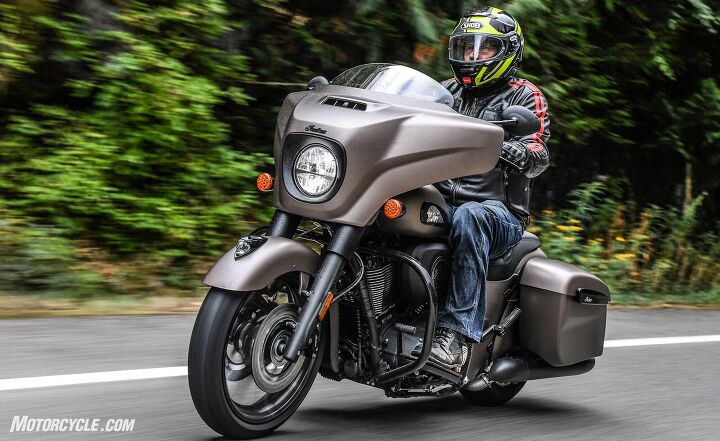





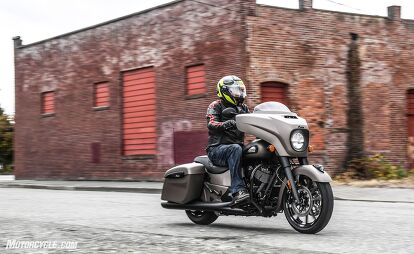































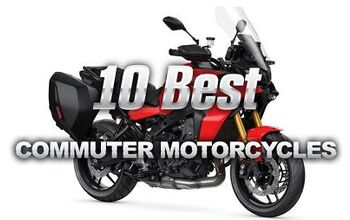


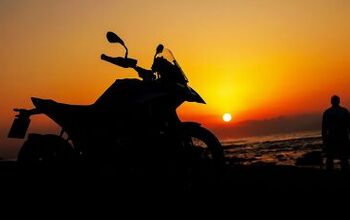










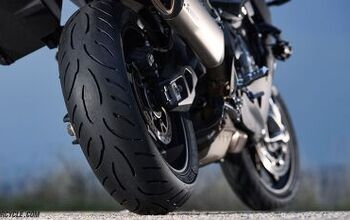

Comments
Join the conversation
Interesting, that's the same tire that HD puts on their touring bikes. Recommendation for a better touring all weather tire for the this bike an the HD touring bikes? Like the new look of the bike as well as an aside.
This new Indian Chieftain is soooo cool, and it gives you a choice over the classic Chieftain, which everyone can still buy, and continue to buy in the foreseeable future. This new one, has, along with some of the other models of Indian Motorcycle, a more "up to date" design. I see someone here think the Indian Chieftain resembles the Harley Streetglide and it's somehow okay, If you are new, or are not familiar with design, then two cars like say 2018 Mustang and 2018 Camaro will look the same. And who cares? They are cars of the same class. What is your point of reference? My grandmother does not really care about cars, for her they will look alike, and good for her. She is no "car man". On the other hand If you are interested in cars, or concerned with design, you will immediately see a difference, and thats ok too. Something else would be ridiculous given that you are a car man - I think that's the thing. Many people will have trouble seeing a difference between let's say a Ducati Panigale and, say, a Aprilia RSV4 RF - Its normal. They may have a certain interest in motorcycles, but they are not that interested. on the other hand when motorcycles are not something that really really interests you, It's a huge difference! - If you' are interested - or have a" trained "eye, or know anything about motorcycle history... It is another story. Wixom, perhaps, was the biggest company to design and build the early Batwing fairings. In the early 60s they built them in many different styles, some big, some small, some with built-in flashes, also with driving lights. Wixom also made Hard bags ( Sort off like the ones on the Street Glide) and other motorcycle stuff. Wixom fairings were mounted on and especially popular on BMW, Moto Guzzi and european motorcycles. The current American "Batwing" style on the Street Glide comes from Wixom, and Harley also acquired the rights of Wixom, Harley Davidson is therefore often associated with the Batwing Fairing. Today, Indian Motorcycle also runs, with its variant, and other brands does so too. - Ok, anyway, Having said that, it is clear that Indian goes straight for the throat of Harley Davidson, But they do it in style and they do it cleverly. I think the "new" face of Indian, or should I say, the "other" face of indian are coming from bikes like the Scout Bobber, the new Springfield Dark Horse, and now the new Chieftain. Definitely from the same manufacturer. and you see family similarities, Cool maybe darker, a bit more in the background, and more quiet sort of speak. - And then we have the rest of the family, which also more resembles each other, being majestic, classical, and sort of loud. When you see all the Indian bikes together, you see that they are all related. This new Chieftain? I think it look great!